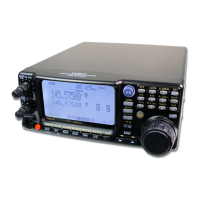
 Loading...
Loading...
Do you have a question about the Yaesu VR-5000 and is the answer not in the manual?
Check the VR-5000 for physical damage upon unpacking.
Lists items included with the VR-5000 receiver.
Lists optional enhancement units for the VR-5000.
Controls for audio volume of MAIN and SUB VFOs and squelch threshold.
Adjusts receiver audio characteristics for SUB VFO.
Connects headphones to the receiver, disabling the internal speaker.
Main on/off switch for the VR-5000 receiver.
Details the liquid crystal display segments and icons.
Explains the primary function keys on the front panel.
Controls for Band Scope sweep width and step size.
Activates scanning functions and M-S scanning feature.
Controls for Programmable Memory Scan and clearing functions.
Adjusts display brightness and priority channel operation.
Recalls preset memories and executes command functions.
Controls for step selection, VFO/Memory modes, and memory banks.
Frequency tuning and direct frequency entry methods.
Activates alternate functions and the DSP unit.
Primary tuning control for frequency, memory, and settings.
Connection point for the DC power supply adapter.
MUTE jack and ANT B terminal for external connections.
Connects low-impedance antennas and selects between ANT A/B.
Jacks for external speaker and constant level audio output.
+8V DC output and 10.7 MHz IF output jacks.
Serial port for computer control via RS-232C.
Guidelines for optimal placement and connecting power sources.
Guidance on antenna placement, types, and essential safety precautions.
Recommendations for antennas below 2 MHz and for short-wave (HF) reception.
Advice on antennas for VHF/UHF bands and how to switch between antenna inputs.
Connecting MUTE, REC, and External Speaker jacks for audio and synchronization.
Utilizing +8V DC output and 10.7 MHz IF output jacks.
Overview of VFO system and procedure for turning the radio on/off.
How to set audio levels, mute background noise, and adjust audio characteristics.
Tuning using the DIAL knob, up/down keys, and direct keypad frequency entry.
How to manually select receiving modes or use AUTO mode.
Adjusting tuning increments and using MAIN/SUB VFOs simultaneously.
Step-by-step guide to setting the current time and UTC.
Using the pre-programmed memory bank for quick tuning of SW broadcasts.
Procedure to update frequencies for the SW broadcast list.
Introduction to the 2000 main memory channels and their grouping.
How to save frequencies into memory channels and groups, and how to retrieve them.
Configuring the receiver to recall all memories, bypassing group selection.
Advanced features like offset tuning, naming memories, and keypad entry sequences.
Assigning labels to memory groups for better organization.
Preventing accidental modification of stored memory data.
Hiding or revealing specific memory channels during scanning.
Searching and recalling memory channels using their assigned text labels.
Monitoring up to 50 memory channels simultaneously.
Installing, monitoring, and deleting channels from the PMR Board.
Sorting memories by tag, frequency, mode, or channel number.
Sorting by ascending/descending channel number, deleting vacant ones.
Using five convenient PS memories for quick recall.
Storing and retrieving frequencies using PS memory channels.
Configuring how the scanner stops on signals (Normal, S-Meter, Voice).
Detailed procedure for setting up S-METER scanning.
Procedure for setting up voice-activated scanning.
How the scanner resumes after stopping on a signal (Delay, Pause, Hold).
Configuring resume techniques for VFO and PMS modes, and Memory scanning.
Configuring scanner to sweep all memories and skipping specific channels.
Initiating and controlling scanning across VFO frequencies.
Setting custom scan limits for specific frequency ranges.
Steps to define and use band limits for scanning.
Changing PMS registers, scan stop modes, and other parameters.
Scanning between MAIN/SUB VFOs and setting scanner dwell timers.
Visualizing activity across frequencies and adjusting scope parameters.
Setting up a memory bank for automatic frequency loading.
Starting, stopping, and disabling the Smart Search function.
Accessing frequencies captured by the Smart Search.
Designating a priority channel and configuring monitoring parameters.
Starting and stopping the priority channel check.
Changing the interval for checking the priority channel.
Viewing time zones and locations worldwide.
Modifying default area names for the World Clock display.
Setting up automatic frequency switching at preset times.
Activating, disabling, and deleting ON/OFF timer settings.
Setting the radio to automatically turn off after a specified duration.
Setting the radio to turn on automatically at a preset time.
Using Notch and Bandpass filters to enhance reception quality.
Activating a narrow filter for crowded CW conditions.
Applying noise reduction and adjusting CW tone frequency.
Controlling RF attenuation, noise blanking, and passband tuning.
Enabling or disabling the keypad's audible feedback.
Preventing accidental changes by locking panel controls.
Adjusting contrast, dimmer, and the [F] key's alternate function duration.
Enabling frequency announcements and recording/playback of audio.
Showing relative signal strength compared to a baseline.
Visualizing audio waveforms and monitoring Radio Control channels.
Transferring memory and configuration data between VR-5000 units.
Using a PC for automated control of VFO and receiving modes.
Details on serial data, byte format, and command opcodes for PC control.
Restoring the VR-5000 to its factory default settings.
Guide for installing the DSP-1 unit.
Guide for installing the DVS-4 unit.
Guide for installing the FVS-1A unit.
Table of default frequency ranges, modes, and steps for AUTO mode.
Summary of frequency range, modes, sensitivity, power, and dimensions.
Notes on scanner capabilities and user modification restrictions.
Declarations regarding compliance with FCC and Industry Canada rules.